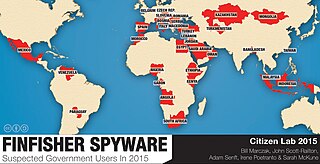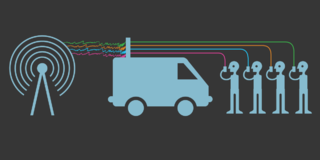Related Research Articles
Spyware is any software with malicious behavior that aims to gather information about a person or organization and send it to another entity in a way that harms the user by violating their privacy, endangering their device's security, or other means. This behavior may be present in malware and in legitimate software. Websites may engage in spyware behaviors like web tracking. Hardware devices may also be affected.
Keystroke logging, often referred to as keylogging or keyboard capturing, is the action of recording (logging) the keys struck on a keyboard, typically covertly, so that a person using the keyboard is unaware that their actions are being monitored. Data can then be retrieved by the person operating the logging program. A keystroke recorder or keylogger can be either software or hardware.
Computer and network surveillance is the monitoring of computer activity and data stored locally on a computer or data being transferred over computer networks such as the Internet. This monitoring is often carried out covertly and may be completed by governments, corporations, criminal organizations, or individuals. It may or may not be legal and may or may not require authorization from a court or other independent government agencies. Computer and network surveillance programs are widespread today and almost all Internet traffic can be monitored.
Center for Democracy & Technology (CDT) is a Washington, D.C.-based 501(c)(3) nonprofit organisation that advocates for digital rights and freedom of expression. CDT seeks to promote legislation that enables individuals to use the internet for purposes of well-intent, while at the same time reducing its potential for harm. It advocates for transparency, accountability, and limiting the collection of personal information.
Email privacy is a broad topic dealing with issues of unauthorized access to, and inspection of, electronic mail, or unauthorized tracking when a user reads an email. This unauthorized access can happen while an email is in transit, as well as when it is stored on email servers or on a user's computer, or when the user reads the message. In countries with a constitutional guarantee of the secrecy of correspondence, whether email can be equated with letters—therefore having legal protection from all forms of eavesdropping—is disputed because of the very nature of email.
The Computer and Internet Protocol Address Verifier (CIPAV) is a data gathering tool that the Federal Bureau of Investigation (FBI) uses to track and gather location data on suspects under electronic surveillance. The software operates on the target computer much like other forms of spyware, whereas it is unknown to the operator that the software has been installed and is monitoring and reporting on their activities.
Workplace privacy is related with various ways of accessing, controlling, and monitoring employees' information in a working environment. Employees typically must relinquish some of their privacy while in the workplace, but how much they must do can be a contentious issue. The debate rages on as to whether it is moral, ethical and legal for employers to monitor the actions of their employees. Employers believe that monitoring is necessary both to discourage illicit activity and to limit liability. With this problem of monitoring employees, many are experiencing a negative effect on emotional and physical stress including fatigue, lowered employee morale and lack of motivation within the workplace. Employers might choose to monitor employee activities using surveillance cameras, or may wish to record employees activities while using company-owned computers or telephones. Courts are finding that disputes between workplace privacy and freedom are being complicated with the advancement of technology as traditional rules that govern areas of privacy law are debatable and becoming less important.
Employee monitoring is the surveillance of workers' activity. Organizations engage in employee monitoring for different reasons such as to track performance, to avoid legal liability, to protect trade secrets, and to address other security concerns. This practice may impact employee satisfaction due to its impact on the employee's privacy. Among organizations, the extent and methods of employee monitoring differ.
Security information and event management (SIEM) is a field within the field of computer security, where software products and services combine security information management (SIM) and security event management (SEM). SIEM is the core component of any typical Security Operations Center (SOC), which is the centralized response team addressing security issues within an organization.
Computer surveillance in the workplace is the use of computers to monitor activity in a workplace. Computer monitoring is a method of collecting performance data which employers obtain through digitalised employee monitoring. Computer surveillance may nowadays be used alongside traditional security applications, such as closed-circuit television.

FinFisher, also known as FinSpy, is surveillance software marketed by Lench IT Solutions plc, which markets the spyware through law enforcement channels.
An insider threat is a perceived threat to an organization that comes from people within the organization, such as employees, former employees, contractors or business associates, who have inside information concerning the organization's security practices, data and computer systems. The threat may involve fraud, the theft of confidential or commercially valuable information, the theft of intellectual property, or the sabotage of computer systems.
Retina-X Studios is a software manufacturer company that develops computer and cell phone monitoring applications, focused on computers, smartphones, tablets and networks. The company is founded in 1997 and it is based in Jacksonville, Florida, United States.

Cellphone surveillance may involve tracking, bugging, monitoring, eavesdropping, and recording conversations and text messages on mobile phones. It also encompasses the monitoring of people's movements, which can be tracked using mobile phone signals when phones are turned on.
Awareness Technologies is a Westport, Connecticut-based American technology company founded in 2002. The company provides security, monitoring, forensic, data loss prevention, productivity and analytics solutions for home, office, and enterprise.
HackingTeam was a Milan-based information technology company that sold offensive intrusion and surveillance capabilities to governments, law enforcement agencies and corporations. Its "Remote Control Systems" enable governments and corporations to monitor the communications of internet users, decipher their encrypted files and emails, record Skype and other Voice over IP communications, and remotely activate microphones and camera on target computers. The company has been criticized for providing these capabilities to governments with poor human rights records, though HackingTeam states that they have the ability to disable their software if it is used unethically. The Italian government has restricted their licence to do business with countries outside Europe.

mSpy is a brand of mobile and computer parental control monitoring software for iOS, Android, Windows, and macOS. The app allows users to monitor and log activity on the client device.
In the field of information security, user activity monitoring (UAM) or user activity analysis (UAA) is the monitoring and recording of user actions. UAM captures user actions, including the use of applications, windows opened, system commands executed, checkboxes clicked, text entered/edited, URLs visited and nearly every other on-screen event to protect data by ensuring that employees and contractors are staying within their assigned tasks, and posing no risk to the organization.
Corporate surveillance describes the practice of businesses monitoring and extracting information from their users, clients, or staff. This information may consist of online browsing history, email correspondence, phone calls, location data, and other private details. Acts of corporate surveillance frequently look to boost results, detect potential security problems, or adjust advertising strategies. These practices have been criticized for violating ethical standards and invading personal privacy. Critics and privacy activists have called for businesses to incorporate rules and transparency surrounding their monitoring methods to ensure they are not misusing their position of authority or breaching regulatory standards.
Stalkerware is monitoring software or spyware that is used for cyberstalking. The term was coined when people started to widely use commercial spyware to spy on their spouses or intimate partners. Stalkerware has been criticized because of its use by abusers, stalkers, and employers.
References
- ↑ "What Is Employee Monitoring Software? (with pictures)". wiseGEEK. Archived from the original on 2018-01-02. Retrieved 2018-01-02.
- ↑ "What is employee monitoring?". WhatIs.com. Archived from the original on 16 February 2018. Retrieved 16 February 2018.
- ↑ Zadelhoff, Marc van (2016-09-19). "The Biggest Cybersecurity Threats Are Inside Your Company". Harvard Business Review. ISSN 0017-8012 . Retrieved 2024-05-29.
- ↑ "Data Breach Investigations Report - 2022" https://www.verizon.com/business/en-gb/resources/2022-data-breach-investigations-report-dbir.pdf (PDF) Verizon, 2022. Retrieved 5/29/2024.
- ↑ Ciocchetti, Corey A. (2011). "The Eavesdropping Employer: A Twenty-First Century Framework for Employee Monitoring". American Business Law Journal. 48 (2): 285–369. doi:10.1111/j.1744-1714.2011.01116.x. ISSN 1744-1714.
- 1 2 Spitzmüller, Christiane; Stanton, Jeffrey M. (June 2006). "Examining employee compliance with organizational surveillance and monitoring". Journal of Occupational and Organizational Psychology. 79 (2): 245–272. doi:10.1348/096317905x52607. ISSN 0963-1798.
- ↑ Gilliland, Donald (2021-07-24). "Warning: Your boss is probably spying on you — and it could be bad for your health". The Hill . Retrieved 2021-12-22.
- 1 2 3 Cole, Samantha (2021-12-08). "Workers Are Using 'Mouse Movers' So They Can Use the Bathroom in Peace". Vice . Retrieved 2021-12-22.
- 1 2 Cyphers, Bennett; Gullo, Karen (2020-06-30). "Inside the Invasive, Secretive "Bossware" Tracking Workers". Electronic Frontier Foundation . Retrieved 2021-12-22.
- 1 2 Klosowski, Thorin (2021-02-10). "How Your Boss Can Use Your Remote-Work Tools to Spy on You". The New York Times . Retrieved 2021-12-22.
- 1 2 Crispin, Jessa (2021-09-16). "Employers are spying on us at home with 'tattleware'. It's time to track them instead". The Guardian . Retrieved 2021-12-22.
- ↑ ‘Bossware is coming for almost every worker’: the software you might not realize is watching you The Guardian. 2022.
- ↑ "Warning: Bossware May Be Hazardous To Your Health" (PDF). Center for Democracy & Technology. 2021. Retrieved 2024-05-15.
- ↑ Scherer, Matt (2021-09-16). "Strategies to Tackle Bossware's Threats to the Health & Safety of Workers". Center for Democracy and Technology . Retrieved 2021-12-22.
- ↑ "Workplace monitoring platform Aware takes in $60M". VentureBeat. 2021-10-13. Retrieved 2022-08-09.